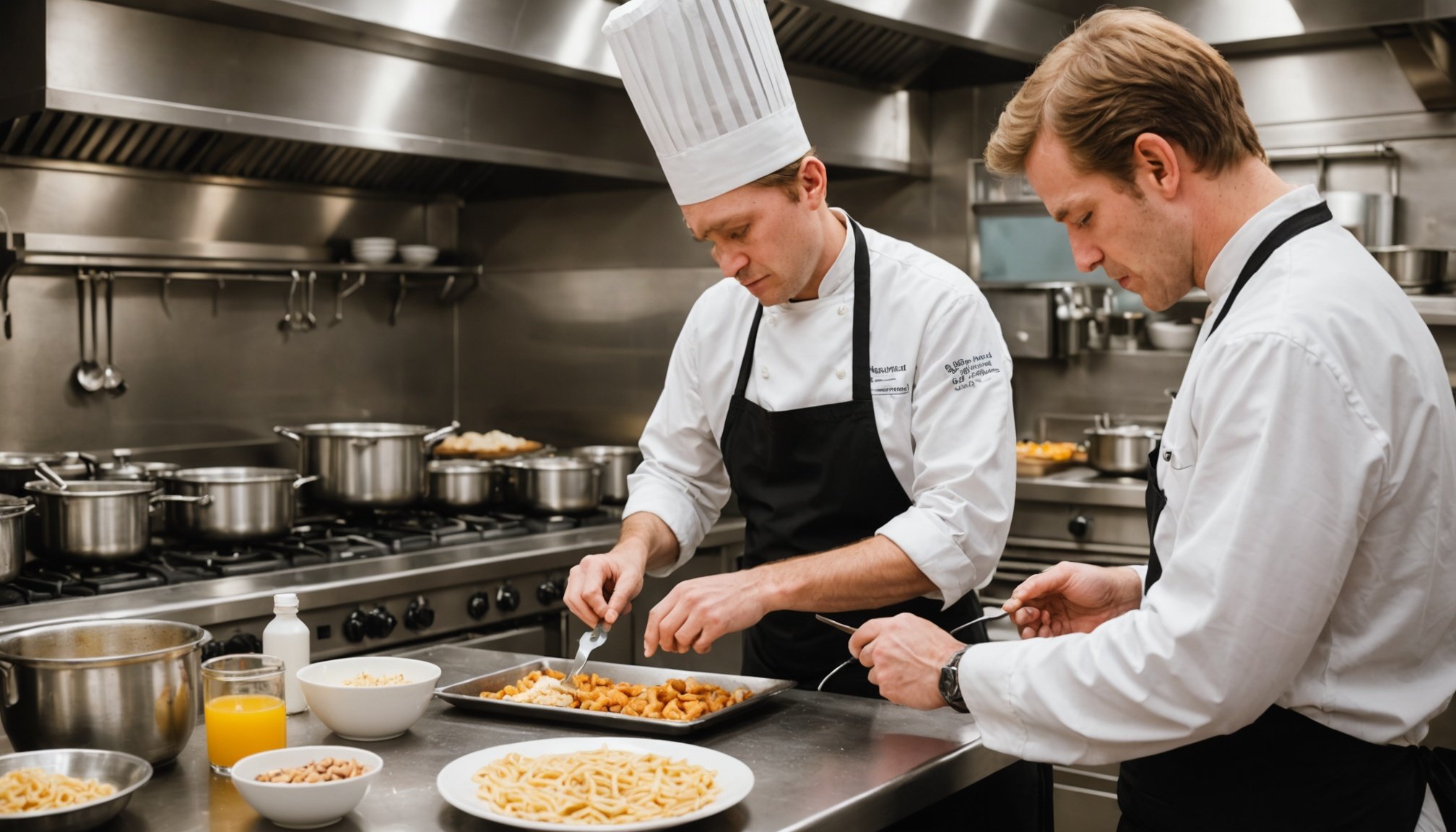In a fast-paced restaurant kitchen, managing food allergies requires precision and proactive strategies. Chefs and staff must work as a cohesive unit to ensure safety for all diners. Implementing clear communication protocols, thorough training, and diligent cross-contamination prevention are essential for creating a secure environment. This overview will explore effective tactics that not only protect guests but also maintain the kitchen's dynamic energy. Fostering a culture of awareness and respect for food allergies elevates the dining experience while safeguarding health.
Effective Communication Strategies
Effective communication is essential in managing food allergy communication in restaurants. Ensuring that all staff members are well-trained on this subject can significantly reduce risks and enhance customer satisfaction. Implementing a standardized communication system is a practical approach to managing allergen information consistently.
Also read : Dynamic strategies for rapidly onboarding restaurant staff with new menu offerings in a high-energy setting
Importance of Clear Communication
Clear communication about food allergies among restaurant staff is crucial. It helps prevent misunderstandings that could lead to serious health incidents. Training programs should focus on educating staff about common allergens and the importance of accurately conveying this information to customers.
In parallel : Essential strategies for achieving maximum freshness in your restaurant”s raw bar
Best Practices for Customer Interaction
When interacting with customers about allergies, staff should be attentive and empathetic. A simple yet effective practice is to ask open-ended questions to understand the customer's needs better. For example, "Could you please specify any allergies we should be aware of?" This approach encourages a dialogue and ensures accurate food allergy communication.
Standardized Communication System
Implementing a standardized system for allergen information can streamline processes and ensure consistency. Such a system may include:
- Allergen menus: Clearly labeled menu items with allergen information.
- Training modules: Regular updates and assessments for staff.
- Communication protocols: Established procedures for discussing allergens with customers.
By adopting these strategies, restaurants can foster a safe dining environment and build trust with their patrons.
Ingredient Handling Protocols
Ensuring safe ingredient handling is essential for effective allergen management in restaurants.
Guidelines for Receiving and Storing Allergenic Ingredients
Proper safe ingredient handling begins with receiving and storing allergenic ingredients. Staff should inspect deliveries for any signs of damage or contamination. Allergenic ingredients must be stored separately to prevent cross-contact. Use clear labels to identify allergens, ensuring they are visible and easily understood by all kitchen staff.
Methods for Labeling and Identifying Allergens in the Kitchen
Labeling is a critical component of allergen management. Implement a color-coded system for easy identification of allergenic ingredients. For instance, use red labels for peanuts and blue for shellfish. This visual method helps maintain food safety practices and minimizes the risk of mistakes during meal preparation.
Steps for Maintaining Ingredient Integrity
To maintain ingredient integrity, establish strict protocols for cleaning and sanitizing equipment used for allergenic ingredients. Use dedicated tools and utensils for allergen-specific tasks. Regularly train staff on food safety practices to ensure they understand the importance of these measures.
Key Practices:
- Separate storage for allergens
- Color-coded labeling system
- Dedicated utensils for allergenic ingredients
By adhering to these allergen management protocols, restaurants can effectively safeguard against cross-contamination and uphold high standards of food safety practices.
Cross-Contamination Prevention Techniques
Implementing robust cross-contamination prevention strategies is crucial in maintaining kitchen hygiene and ensuring allergen safety.
Strategies for Food Separation
In the kitchen, separate allergenic from non-allergenic foods during preparation. Use dedicated preparation areas to minimize the risk of cross-contamination. Employing separate cutting boards and containers for allergenic ingredients is a practical measure. This approach ensures that allergens do not inadvertently come into contact with other foods.
Designated Equipment and Utensils
Utilize designated equipment and utensils specifically for allergen-free dishes. This practice is essential for maintaining allergen safety. For example, color-coded utensils can help staff easily identify the right tools for each task. Consistent use of dedicated equipment helps uphold kitchen hygiene standards.
Regular Cleaning Protocols
Regular cleaning protocols are vital to minimize contamination risks. Establish a routine for sanitizing surfaces and equipment after each use, especially when handling allergens. This reduces the potential for cross-contamination and supports a safe kitchen environment.
Key Practices:
- Separate preparation areas
- Color-coded utensils
- Routine sanitization
By adhering to these strategies, restaurants can significantly enhance allergen safety and maintain high levels of kitchen hygiene.
Staff Training and Checklists
Ensuring staff are well-informed and equipped to manage allergen safety effectively.
Developing a Comprehensive Training Program
Creating a comprehensive training program is essential for raising allergen awareness among restaurant staff. This program should cover various aspects of food allergies, from identification to prevention of cross-contamination. Regular workshops and interactive sessions can help reinforce knowledge and ensure that staff are updated on the latest allergen policies.
Creating Checklists for Daily Operations
To maintain high standards of allergen safety, implementing detailed kitchen checklists is crucial. These checklists should include daily tasks such as verifying ingredient labels, checking storage conditions, and ensuring the use of dedicated utensils. A well-structured checklist serves as a constant reminder for staff to adhere to allergen management protocols.
- Verify ingredient labels
- Check storage conditions
- Use dedicated utensils
Encouraging Ongoing Education
Ongoing education is vital for sustaining allergen awareness. Encourage staff to participate in continuous learning opportunities, such as online courses and seminars. Regular updates on allergen policies should be communicated to ensure everyone is informed about changes and best practices. This commitment to education fosters a proactive approach to allergen safety.
Real-Life Case Studies and Examples
Exploring successful allergen management in high-energy kitchens.
Analysis of Successful Allergen Management
In the bustling world of high-energy kitchens, effective allergen management is imperative. One notable case study involves a renowned restaurant chain that implemented a comprehensive allergen protocol. By introducing a standardized communication system, they significantly reduced allergen incidents. This success story highlights the importance of thorough staff training and dedicated utensils for allergen-specific tasks.
Lessons Learned from Challenges
Restaurants facing allergen-related challenges have valuable lessons to share. For instance, a local bistro encountered a cross-contamination issue due to inadequate labeling. Learning from this, they adopted a color-coded system, transforming their approach to allergen safety. This change not only improved their operations but also bolstered customer trust.
Innovative Solutions by Industry Leaders
Industry leaders have pioneered innovative solutions to tackle allergen challenges. A prominent example is a restaurant that integrated technology into their allergen management. By utilizing digital menus with real-time allergen updates, they enhanced accuracy and efficiency in customer interactions. Such solutions demonstrate the potential of combining technology with traditional practices to achieve exemplary allergen management.
- Key Practices:
- Comprehensive allergen protocols
- Color-coded systems
- Digital allergen updates
These case studies and examples serve as a beacon for others in the industry, showcasing practical strategies and innovative solutions for effective allergen management.
Regulatory Guidelines and Compliance
Compliance with food allergy regulations is essential for restaurant safety and customer trust.
Overview of Food Allergy Regulations
Restaurants must adhere to strict food allergy regulations to ensure customer safety. These regulations mandate clear labeling of allergenic ingredients and require establishments to maintain accurate allergen information. Non-compliance can lead to severe legal repercussions and damage to reputation.
Legal Implications of Allergen Management
Understanding the legal implications of food allergen management is crucial for restaurant operators. Failure to comply with compliance standards can result in fines, legal action, and loss of business licenses. It is imperative that restaurants implement robust allergen protocols to mitigate these risks.
Best Practices for Maintaining Compliance
Maintaining compliance while ensuring efficiency in a busy kitchen involves several best practices:
- Regular staff training: Educate employees on food allergy regulations and proper handling techniques.
- Accurate labeling: Ensure all menu items are clearly labeled with potential allergens.
- Routine audits: Conduct regular checks to verify adherence to compliance standards.
By integrating these practices, restaurants can effectively manage food allergen management obligations, safeguarding both their customers and their business interests. Compliance not only enhances safety but also builds trust with patrons, fostering a positive dining experience.













